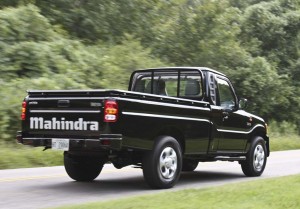
Indian automaker Mahinda plans to begin marketing two models in the U.S., including two versions of the Pik-Up, and an SUV.
It’s been more than two years since we first heard Mahindra was bringing small diesel pickups to the U.S. During that time we’ve covered a steady stream of news about the Indian company and its American distributor Global Vehicles U.S.A., but we’ve most wanted to know: How will these trucks perform and can they live up to the high expectations of American truck buyers?
To find out we drove two foreign-market Mahindra trucks – a left-hand drive version of the recently updated Australian Pik-Up and a Scorpio SUV – down near Atlanta earlier this week.
The two trucks aren’t identical to the rigs that will go on sale here – the two-door TR20 and four-door TR40 pickups (coming in February) and the SUV (due later in 2010) – but they’re close enough so that the single cab Pik-Up and “mHawk” diesel-powered Scorpio with a six-speed automatic give us a reasonable idea of what the stateside pickup’s powertrain will be like.
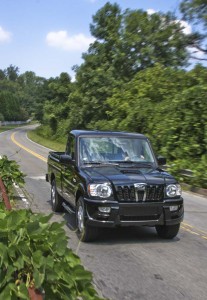
Mahindra will import two versions of the truck, a two-door and a four-door, starting next year.
It was impossible to walk up to these Indian vehicles for the first time without thinking they have to have problems and wanting to immediately start calling them out. Quality, design, power, driving feel – you name it and the concern exists. What we found was that parts of the trucks managed to only live up to our low expectations, but we also came away impressed — no, stunned really — by how well the trucks performed in certain areas.
We drove the regular cab Pik-Up first with a 7-foot bed. It’s powered by Mahindra’s 2.5-liter common rail diesel engine that’s rated at 105 horsepower and 182 pounds-feet of torque and coupled to a five-speed manual transmission. It’s a generation earlier than the 2.2-liter mHawk and won’t be available in the U.S.
The Pik-Up recently got a styling overhaul that’s very close to how the TR20 pickup will look, but it hasn’t lost the boxy profile and fussy design elements that gives it the distinct vibe of a third-world hauler.
On the outside, Mahindra has strengthened the looks of the front bumper and given its corporate logo a more prominent spot on the grille. The headlights have a contemporary look with embedded LED turn signals. The cargo box is old school, with external tie-down hooks like the ones that import trucks used to offer, but the bed is impressively deep and wide enough, at 5-feet 3-inches, easily handling 4×8 sheets of plywood. Rain gutters around the roofline carry water away from the windshield and doors.
The upright cab is much taller than the relatively swept-back style of modern American pickups. There’s lots of headroom for a 6-foot-tall driver without hitting the ceiling, but the greenhouse feels smaller than we’re used to because the seating position is so close to where the A-pillar meets the hood. The only truck we can compare it to is the Hummer H3T, which has an A-pillar with an even more extreme angle; in the H3T, though, the driver sits several inches farther back from the dash cowl, giving it an airier feel.
The Pik-Up’s cabin width is compact. The recent styling update gave the truck bigger seats to fit wider American backsides, but this puts you right next to your passenger. It feels no wider than a Ford Ranger, the only true compact pickup left in the market. This is not a negative:
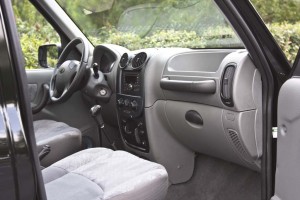
A recent styling update gave the truck bigger seats to fit wider American backsides.
Where some truck manufacturers got the notion that compact trucks had to grow into large midsize trucks, we don’t know, but we appreciate the Pik-Up’s width in tight parking spots and as a way to differentiate it from half-ton pickups.
The tight, tall cabin gives the driver excellent visibility out of the side windows and over the hood and the rear glass has integrated defrosters. The sightlines are best in class; you always know where the Pik-Up is in relation to other vehicles and when navigating tight spots.
The interior is the weakest part of the Pik-Up with controls and materials that are about two generations behind U.S. trucks and that all over the map in terms of quality, refinement and feel. Door sill plates are literally no more than bolted-down plastic strips and there are several points where the carpet ends before it meets the trim pieces or flows under the seats, dash or console. A strange vertical lever immediately to the left of the steering wheel is used for tilt control instead of being attached to the steering column.
There are noticeable gaps where pieces of plastic join to frame components such as the turn signal stalk and the washer levers, the upper and lower portions of the dash and the glovebox. The advanced AM/FM/CD/MP3 audio system looks very similar to the Delco units in GM cars and trucks. It also has USB, auxiliary input and SD-card ports, something many U.S. midsize trucks don’t have. The HVAC controls each felt different when turned: The mode selector felt crisp and clean while the temperature control resisted each turn.
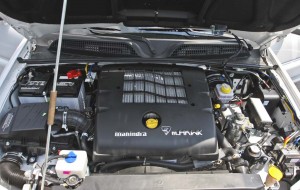
We drove the Pik-Up with Mahindra’s 2.5-liter common rail diesel engine that’s rated at 105 horsepower and 182 pounds-feet of torque.
We drove the Pik-Up unloaded on a loop that took us around Atlanta’s suburban and rural roads and the Georgia 400 tollway. What most impressed was the Pik-Up’s driving manners. Mahindra’s pickups are naturally set up to carry those crazy-heavy payloads in developing countries, so we expected a joltingly stiff ride, but the version we drove has surprisingly good road feel. The steering isn’t numb or loose, but is reasonably solid.
When we turned corners or changed lanes at highway speeds there was very little body roll or handling slop. The truck goes where it’s directed with minimal fuss. As much as we beat up on the interior, there weren’t any noticeable shakes or rattles, though the small cabin had louder than average wind noise. Overall, ride quality and noise, vibration and harshness is very competitive with current U.S. midsize pickups, if not superior to some. Shocking, we know, but it’s true. This is a truck that could function as a daily driver as well as a workhorse.
The 2.5-liter diesel and five-speed manual aren’t coming here, but they are well matched to the Pik-Up’s needs. The motor clatters like a modern diesel, not like the third world mill we’d expected. Every shift was clean except for third gear, which requires a longer throw to the right and more shift gate hunting than we’d like. The footwells are small and pedal spacing too tight for our wide American feet. It takes some getting used to make sure you don’t hit two pedals at once, which we did once coming to a stop, when we put the truck in neutral while accidentally hitting the brake pedal and accelerator at the same time. You only do that once before you learn the right spacing for your feet.
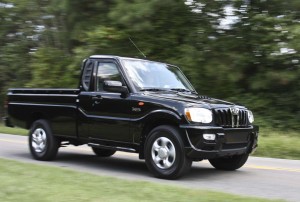
Mahindra is on track to become the first Indian automaker to enter the U.S. market.
The Scorpio SUV is a different story. It has a less powerful version of the 2.2-liter mHawk than the U.S. will receive – rated at 120 horsepower and 214 lbs.-ft. of torque in the Scorpio versus approximately 140 hp and 240 lbs.-ft of torque in the TR Series pickups — but the powertrain feels significantly livelier than the larger 106 horsepower 2.5-liter motor, up to a point. It’s quiet too though there’s transient engine noise that leaks into the cabin during driving.
The six-speed automatic transmission (coming to the U.S. and an exclusive in the small truck segment) executes shifts smoothly and doesn’t hunt for the right cog, at least on the flat ground that we drove it on, but there’s noticeable turbo lag at times. We’ll be very interested to see what impact diesel engineering firm AVL has as a key supplier and consultant for Mahindra in tweaking the mHawk to meet the performance expectations of U.S. buyers. In the Scorpio, we wish we could combine the mHawk with the Pik-Up’s 5-speed manual to improve the performance band a bit more.
The Scorpio’s interior is much more luxurious than the Pik-Up’s, with leather seats, beige trim instead of gray and fake wood accents. It also has fit issues, but not to the degree of the Pik-Up.
On-road performance lags considerably in the SUV. There’s considerable body roll around turns, the handling and steering feels loose and sloppy. The brake pedal takes a lot of pressure to stop the truck, and even then, the disc brakes never seem to want to grip as hard as you’d like or need them too. None of this is particularly surprising, since the arrival of the Scorpio SUVs in the U.S. is much farther out on the horizon and they’re sure to be tweaked to American preferences. All we wanted to learn was how the mHawk powertrain performed and we came away relatively impressed and cautiously optimistic.
Overall, we’re impressed with Mahindra’s four-cylinder diesel pickup truck – much more so than before we drove it. The interior has glaring weaknesses but if this truck can live up to Global Vehicle’s marketing hype of up to 30 mpg, 1.3-tons of payload and 5,000 pounds of towing ability, Mahindra and Global Vehicles will have a pickup truck like no other to sell to U.S. truck buyers. They’ll effectively be competing in a segment of one and in cases where a heavy duty diesel is overkill for the application, we think they’ll be an excellent alternative to help out on a farm or construction site.
Mike Levine is founder and publisher of PickupTrucks.com.
